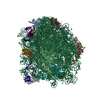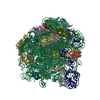[English] 日本語
 Yorodumi
Yorodumi- PDB-7ttw: 50S ribosomal subunit from Staphylococcus aureus containing doubl... -
+ Open data
Open data
- Basic information
Basic information
| Entry | Database: PDB / ID: 7ttw | |||||||||||||||||||||||||||||||||||||||||||||||||||||||||||||||||||||||||||||||||
|---|---|---|---|---|---|---|---|---|---|---|---|---|---|---|---|---|---|---|---|---|---|---|---|---|---|---|---|---|---|---|---|---|---|---|---|---|---|---|---|---|---|---|---|---|---|---|---|---|---|---|---|---|---|---|---|---|---|---|---|---|---|---|---|---|---|---|---|---|---|---|---|---|---|---|---|---|---|---|---|---|---|---|
| Title | 50S ribosomal subunit from Staphylococcus aureus containing double mutation in uL3 imparting linezolid resistance | |||||||||||||||||||||||||||||||||||||||||||||||||||||||||||||||||||||||||||||||||
 Components Components |
| |||||||||||||||||||||||||||||||||||||||||||||||||||||||||||||||||||||||||||||||||
 Keywords Keywords | RIBOSOME / 50S subunit / antibiotic resistance / linezolid | |||||||||||||||||||||||||||||||||||||||||||||||||||||||||||||||||||||||||||||||||
| Function / homology |  Function and homology information Function and homology informationlarge ribosomal subunit / transferase activity / 5S rRNA binding / ribosomal large subunit assembly / large ribosomal subunit rRNA binding / cytosolic large ribosomal subunit / cytoplasmic translation / tRNA binding / negative regulation of translation / rRNA binding ...large ribosomal subunit / transferase activity / 5S rRNA binding / ribosomal large subunit assembly / large ribosomal subunit rRNA binding / cytosolic large ribosomal subunit / cytoplasmic translation / tRNA binding / negative regulation of translation / rRNA binding / structural constituent of ribosome / ribosome / translation / ribonucleoprotein complex / mRNA binding / cytoplasm Similarity search - Function | |||||||||||||||||||||||||||||||||||||||||||||||||||||||||||||||||||||||||||||||||
| Biological species |  | |||||||||||||||||||||||||||||||||||||||||||||||||||||||||||||||||||||||||||||||||
| Method | ELECTRON MICROSCOPY / single particle reconstruction / cryo EM / Resolution: 2.9 Å | |||||||||||||||||||||||||||||||||||||||||||||||||||||||||||||||||||||||||||||||||
 Authors Authors | Belousoff, M.J. / Piper, S. / Johnson, R. | |||||||||||||||||||||||||||||||||||||||||||||||||||||||||||||||||||||||||||||||||
| Funding support |  United States, United States,  Australia, 3items Australia, 3items
| |||||||||||||||||||||||||||||||||||||||||||||||||||||||||||||||||||||||||||||||||
 Citation Citation |  Journal: Microbiol Spectr / Year: 2022 Journal: Microbiol Spectr / Year: 2022Title: A Structurally Characterized Evolutionary Escape Route from Treatment with the Antibiotic Linezolid. Authors: Laura Perlaza-Jiménez / Kher-Shing Tan / Sarah J Piper / Rachel M Johnson / Rebecca S Bamert / Christopher J Stubenrauch / Alexander Wright / David Lupton / Trevor Lithgow / Matthew J Belousoff /  Abstract: Methicillin-resistant Staphylococcus aureus (MRSA) is a bacterial pathogen that presents great health concerns. Treatment requires the use of last-line antibiotics, such as members of the ...Methicillin-resistant Staphylococcus aureus (MRSA) is a bacterial pathogen that presents great health concerns. Treatment requires the use of last-line antibiotics, such as members of the oxazolidinone family, of which linezolid is the first member to see regular use in the clinic. Here, we report a short time scale selection experiment in which strains of MRSA were subjected to linezolid treatment. Clonal isolates which had evolved a linezolid-resistant phenotype were characterized by whole-genome sequencing. Linezolid-resistant mutants were identified which had accumulated mutations in the ribosomal protein uL3. Multiple clones which had two mutations in uL3 exhibited resistance to linezolid, 2-fold higher than the clinical breakpoint. Ribosomes from this strain were isolated and subjected to single-particle cryo-electron microscopic analysis and compared to the ribosomes from the parent strain. We found that the mutations in uL3 lead to a rearrangement of a loop that makes contact with Helix 90, propagating a structural change over 15 Å away. This distal change swings nucleotide U2504 into the binding site of the antibiotic, causing linezolid resistance. Antibiotic resistance poses a critical problem to human health and decreases the utility of these lifesaving drugs. Of particular concern is the "superbug" methicillin-resistant Staphylococcus aureus (MRSA), for which treatment of infection requires the use of last-line antibiotics, including linezolid. In this paper, we characterize the atomic rearrangements which the ribosome, the target of linezolid, undergoes during its evolutionary journey toward becoming drug resistant. Using cryo-electron microscopy, we describe a particular molecular mechanism which MRSA uses to become resistant to linezolid. | |||||||||||||||||||||||||||||||||||||||||||||||||||||||||||||||||||||||||||||||||
| History |
|
- Structure visualization
Structure visualization
| Structure viewer | Molecule:  Molmil Molmil Jmol/JSmol Jmol/JSmol |
|---|
- Downloads & links
Downloads & links
- Download
Download
| PDBx/mmCIF format |  7ttw.cif.gz 7ttw.cif.gz | 1.7 MB | Display |  PDBx/mmCIF format PDBx/mmCIF format |
|---|---|---|---|---|
| PDB format |  pdb7ttw.ent.gz pdb7ttw.ent.gz | 1.3 MB | Display |  PDB format PDB format |
| PDBx/mmJSON format |  7ttw.json.gz 7ttw.json.gz | Tree view |  PDBx/mmJSON format PDBx/mmJSON format | |
| Others |  Other downloads Other downloads |
-Validation report
| Summary document |  7ttw_validation.pdf.gz 7ttw_validation.pdf.gz | 1.4 MB | Display |  wwPDB validaton report wwPDB validaton report |
|---|---|---|---|---|
| Full document |  7ttw_full_validation.pdf.gz 7ttw_full_validation.pdf.gz | 1.4 MB | Display | |
| Data in XML |  7ttw_validation.xml.gz 7ttw_validation.xml.gz | 120.6 KB | Display | |
| Data in CIF |  7ttw_validation.cif.gz 7ttw_validation.cif.gz | 207.5 KB | Display | |
| Arichive directory |  https://data.pdbj.org/pub/pdb/validation_reports/tt/7ttw https://data.pdbj.org/pub/pdb/validation_reports/tt/7ttw ftp://data.pdbj.org/pub/pdb/validation_reports/tt/7ttw ftp://data.pdbj.org/pub/pdb/validation_reports/tt/7ttw | HTTPS FTP |
-Related structure data
| Related structure data |  26125MC  7ttuC C: citing same article ( M: map data used to model this data |
|---|---|
| Similar structure data | Similarity search - Function & homology  F&H Search F&H Search |
- Links
Links
- Assembly
Assembly
| Deposited unit | 
|
|---|---|
| 1 |
|
- Components
Components
+50S ribosomal protein ... , 25 types, 25 molecules ABCDEFGHIJKLMNOPQRSVWXYZa
-RNA chain , 2 types, 2 molecules 12
| #26: RNA chain | Mass: 946680.625 Da / Num. of mol.: 1 / Source method: isolated from a natural source / Source: (natural)  |
|---|---|
| #27: RNA chain | Mass: 36998.973 Da / Num. of mol.: 1 / Source method: isolated from a natural source / Source: (natural)  |
-Details
| Has protein modification | Y |
|---|
-Experimental details
-Experiment
| Experiment | Method: ELECTRON MICROSCOPY |
|---|---|
| EM experiment | Aggregation state: PARTICLE / 3D reconstruction method: single particle reconstruction |
- Sample preparation
Sample preparation
| Component | Name: 50S ribosomal subunit from Staphylococcus aureus - double mutation in uL3 leading to linezolid resistance Type: RIBOSOME / Entity ID: all / Source: NATURAL |
|---|---|
| Molecular weight | Experimental value: NO |
| Source (natural) | Organism:  |
| Buffer solution | pH: 7.4 |
| Specimen | Conc.: 0.3 mg/ml / Embedding applied: NO / Shadowing applied: NO / Staining applied: NO / Vitrification applied: YES |
| Vitrification | Cryogen name: ETHANE |
- Electron microscopy imaging
Electron microscopy imaging
| Microscopy | Model: TFS GLACIOS |
|---|---|
| Electron gun | Electron source:  FIELD EMISSION GUN / Accelerating voltage: 200 kV / Illumination mode: FLOOD BEAM FIELD EMISSION GUN / Accelerating voltage: 200 kV / Illumination mode: FLOOD BEAM |
| Electron lens | Mode: BRIGHT FIELD / Nominal defocus max: 1500 nm / Nominal defocus min: 500 nm / C2 aperture diameter: 50 µm |
| Image recording | Electron dose: 47.5 e/Å2 / Detector mode: COUNTING / Film or detector model: FEI FALCON III (4k x 4k) |
- Processing
Processing
| Software | Name: PHENIX / Version: 1.19.2_4158: / Classification: refinement | ||||||||||||||||||||||||
|---|---|---|---|---|---|---|---|---|---|---|---|---|---|---|---|---|---|---|---|---|---|---|---|---|---|
| EM software | Name: PHENIX / Category: model refinement | ||||||||||||||||||||||||
| CTF correction | Type: PHASE FLIPPING AND AMPLITUDE CORRECTION | ||||||||||||||||||||||||
| 3D reconstruction | Resolution: 2.9 Å / Resolution method: FSC 0.143 CUT-OFF / Num. of particles: 307600 / Symmetry type: POINT | ||||||||||||||||||||||||
| Refine LS restraints |
|
 Movie
Movie Controller
Controller



 PDBj
PDBj





























